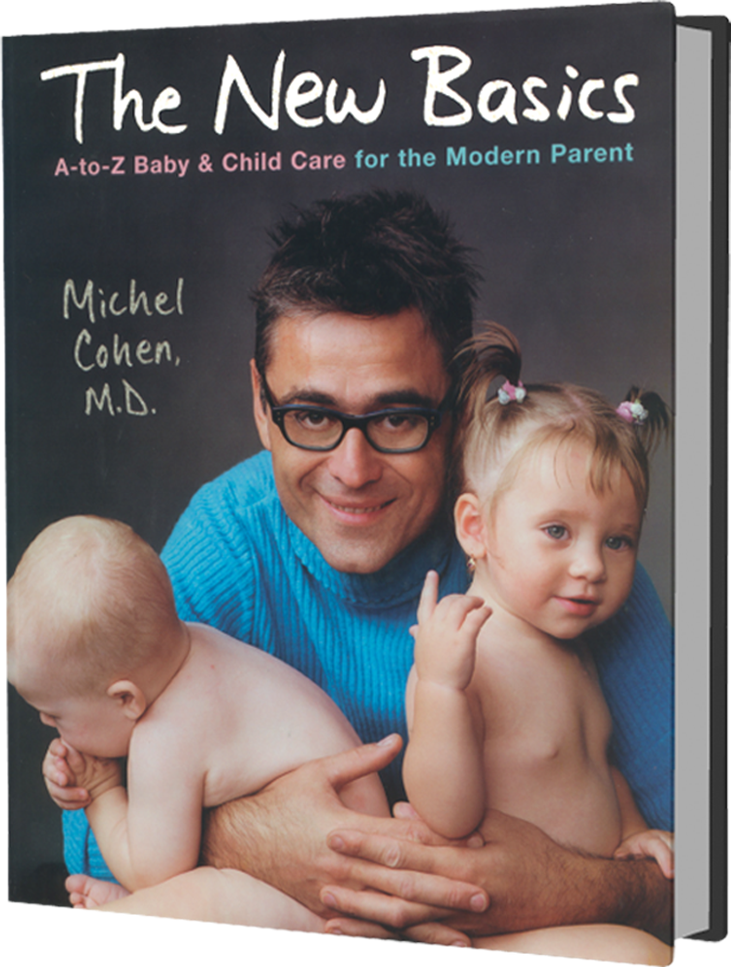
Stomach Bugs
As far as how your darling might pick up these bugs, let’s just say that in medical terms it goes by the poetic name of feco-oral or oro-fecal transmission.
Vomiting from a Stomach Virus
Vomiting can be quite violent, especially at the onset of the illness. At first, food comes out, but soon there is no more food, only a thin green bile. In general, vomiting won’t last for more than twenty-four hours, especially if the fluid is replaced. Even more than diarrhea, vomiting can cause dehydration.
In Infants
 Stomach viruses are rare in infants, since tiny tots don’t attend nursery school, but when a virus does strike (possibly brought home by an older sibling), vigilance is the key. An infant, especially a young one, can become very dehydrated after just a few hours of vomiting. Keep in mind that other causes of vomiting, such as blockage of the intestine, may be mistaken for a stomach virus.
Stomach viruses are rare in infants, since tiny tots don’t attend nursery school, but when a virus does strike (possibly brought home by an older sibling), vigilance is the key. An infant, especially a young one, can become very dehydrated after just a few hours of vomiting. Keep in mind that other causes of vomiting, such as blockage of the intestine, may be mistaken for a stomach virus.
If Lucy suddenly vomits on more than one occasion (and if it’s real vomiting instead of just a little spitting up), you should continue to feed her breast milk or formula in small amounts, and call your doctor for advice.
In Older Infants and Children
 With older kids, vomiting can usually be handled at home with simple measures. The goal is to prevent dehydration in the first twenty-four hours by replacing fluids. If you manage to replenish the liquids he’s losing, Jimmy’s body will do the rest and build its defenses to banish the viral intruder.
With older kids, vomiting can usually be handled at home with simple measures. The goal is to prevent dehydration in the first twenty-four hours by replacing fluids. If you manage to replenish the liquids he’s losing, Jimmy’s body will do the rest and build its defenses to banish the viral intruder.
If the vomiting persists for more than twenty-four hours, especially if it remains intense.
If the tiniest amount of fluid makes Jimmy vomit.
If there are signs of dehydration. If Jimmy becomes dehydrated, he’ll appear tired and pale. His eyes will barely stay open, and he’ll produce very little urine. These signs indicate that oral rehydration isn’t working. You should go to the doctor’s office or the hospital so Jimmy can receive intravenous fluids.
If Jimmy remains active.
If the vomiting recurs once or twice after subsiding for a day or two.This may indicate that you have been too quick to reintroduce foods that are a little tough on the tummy, such as pizza, despite Jimmy’s encouraging cravings.
Give Jimmy the tiniest amount of liquid he will tolerate without vomiting, but give it almost continuously until the vomiting has settled. Use an eyedropper if you have to, and go sloooowly. Too much volume will distend and irritate the intestine, and that will trigger more vomiting.
As far as the type of liquid, you can use any soft drink (cola, ginger ale, sports drink) diluted by half with water and served at room temperature. Commercial rehydration solutions such as Pedialyte are expensive and not really any more effective than sodas at preventing dehydration.
For Lucy, you can use small quantities of breast milk or formula diluted with twice as much water. If she vomits more than a couple of times, switch her to clear fluids, just as you would an older child.
Give only fluid until at least six hours after the vomiting ends. You can then start reintroducing very bland solid foods, such as crackers or dry cereal. Again, go very slowly. If Jimmy tolerates food, you can creep back toward a regular diet. If at any time vomiting begins again, go back to the fluid replacement as explained above.
Don’t use only water. You need to replace minerals, salts, and sugars, along with the water.
Don’t reintroduce solid foods too quickly.
Don’t give cow’s milk or full-strength formula until the vomiting has subsided.
Don’t use antivomiting suppositories. They’re inefficient and potentially dangerous.
In most cases, vomiting will last for a day or so and then subside. It could be followed by diarrhea, which entails another set of problems (see below).
Diarrhea from a Stomach Virus
Diarrhea may follow vomiting or appear on its own. It can vary from a few loose stools to very watery stools [See: Stools].
In Infants
 Diarrhea is hard to define here, since young infants can normally have up to ten very runny poops per day. A greater frequency than that could represent diarrhea, especially if the constituency is very runny. Since the very young are at greater risk of dehydration, offer small amounts of breast milk or formula, and call your doctor for advice.
Diarrhea is hard to define here, since young infants can normally have up to ten very runny poops per day. A greater frequency than that could represent diarrhea, especially if the constituency is very runny. Since the very young are at greater risk of dehydration, offer small amounts of breast milk or formula, and call your doctor for advice.
In Children
 Diarrhea following a stomach virus is messy but usually not serious, though you may be surprised by how long the loose stools persist. Diaper rash is the most common inconvenience. Compared to vomiting, diarrhea rarely causes worrisome dehydration, but there’s still a risk.
Diarrhea following a stomach virus is messy but usually not serious, though you may be surprised by how long the loose stools persist. Diaper rash is the most common inconvenience. Compared to vomiting, diarrhea rarely causes worrisome dehydration, but there’s still a risk.
If there’s blood or mucus in the diarrhea
If the diarrhea is extremely frequent (more than eight times daily)
If there are signs of dehydration (see above)
If there is a persistent high fever (over 102°F)
Any of these symptoms could indicate a more virulent bacterial infection or viral strain, which would require medical attention.
When the diarrhea lasts. This is more the rule than the exception. It can take up to a month after a stomach virus for the stools to return to a normal consistency. This does not mean that the virus is still present; rather, it takes time for the intestine to heal and be able to reabsorb water. Stool analysis or cultures have no benefits, since the infection is gone. Just have patience.
Feed Jimmy whatever you would normally, High bulk diets have no real value, and since it’s going to last for a while, you might as well be feeding him real foods.
Prevent outbreaks of diaper rash with naked time when practical, and take the other preventive measures described in the DIAPER RASH entry.
For a few days after the vomiting or diarrhea, Jimmy’s appetite will usually decrease, and you may even see some of his ribs showing. It could be a while before he goes back to eating with his old enthusiasm and regains the weight he’s just lost. If you pressure him to eat, you could end up with a picky eater or a child who overindulges in sweets and starches. If you don’t, I promise you that this low-appetite phase will be followed by a period when he’ll be voracious, wolfing down everything you put in front of him and calling for more. At that point, you’ll see the spaces between his ribs fill in.




 MEDICATION DOSAGE
MEDICATION DOSAGE

